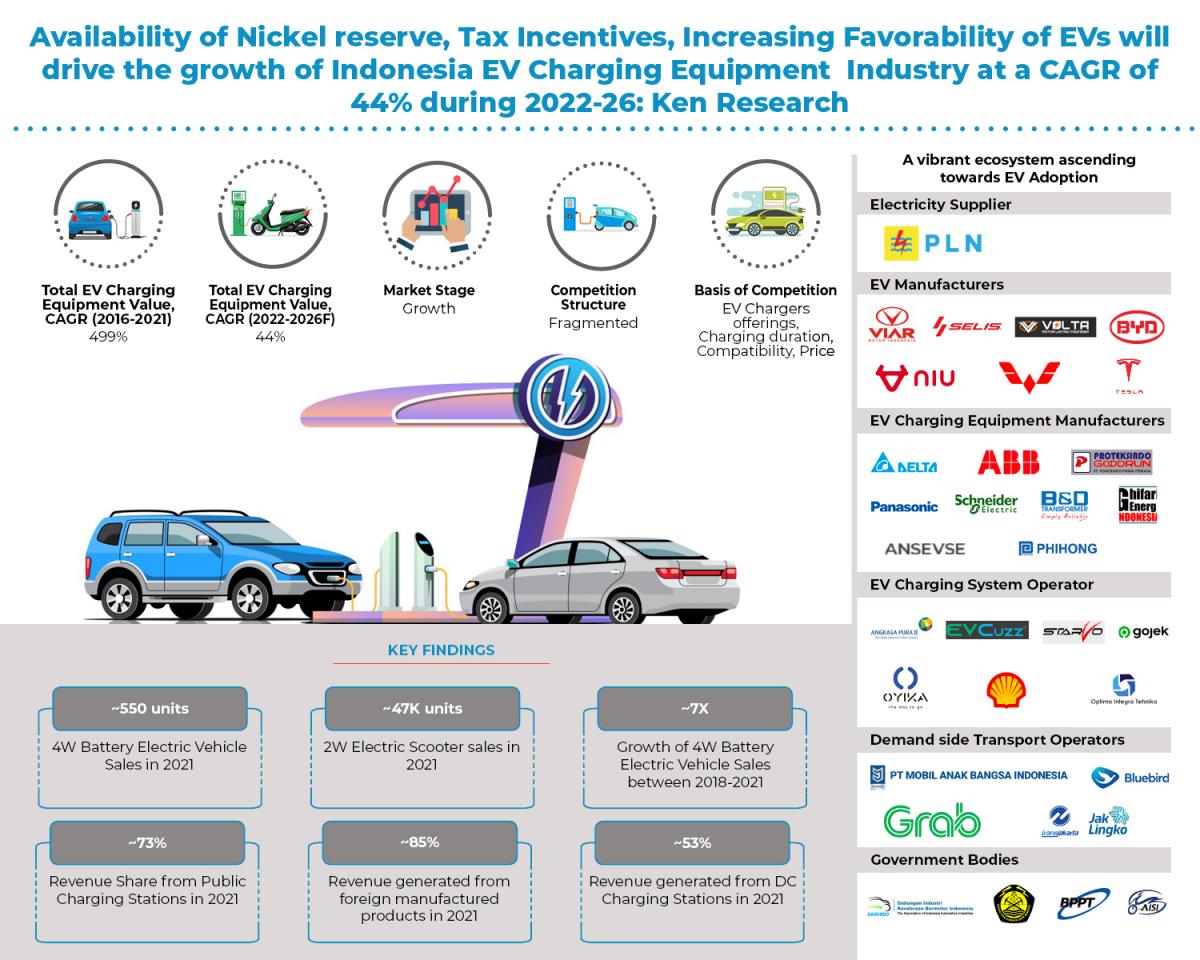Indonesia Electric Vehicle Charging Equipment Market Outlook to 2026: Ken Research

The publication titled ‘Indonesia Electric Vehicle Charging Equipment Market Outlook to 2026: Driven by influx of investment from abroad coupled with increasing focus on emission control’ covers the overview of EV Charging Equipment Industry by analyzing historical EV Charging statistics and corresponding change in Middle Affluent Class in Indonesia. The report covers various aspects including EV Charging Equipment industry market size on the basis of total revenue generated from the charging equipment. Furthermore, the report provides a comprehensive insight on industry trends & developments, issues and challenges, ecosystem, value chain analysis, SWOT Analysis, rules & regulations, growth levers of industry; comparison of top EV Charging Equipment Manufacturers on the basis of Overview, Products, Business Streams, Manufacturing Capabilities, Distribution Channels, Recent Projects, Cost Structure, and Awards and Recognitions. The report also focuses on Indonesian EV Charging Equipment Industry segmentation by Type of Remittance by Type of Charging, Type of Chargers, Type of Vehicle, Type of Geography, and By Sales Channels. The EV Charging section of the report concludes with projections for the future of the industry included forecasted total EV Charging Equipment revenue by 2026, and analysts’ take on the future highlighting major opportunities.
Overview of Electric Vehicle Industry in Indonesia:
Indonesia is the fourth largest country in the world, with a population of nearly 250 million people. With fast economic growth and rapid urbanization in Indonesia, it is projected that more people will acquire a personal vehicle for mobility. The transportation sector is one of the most significant contributors to CO2 emissions in Indonesia, second to the industrial sector. In 2019, Presidential Regulation Number 55 Year 2019 regarding the Acceleration Program for Battery Electric Vehicles for Road Transportation was enacted. This regulation acts as the legal umbrella for Indonesian electric vehicle development and creates a domino effect for several ministries to start electric vehicle (EV) projects in Indonesia. The Battery Electric Vehicles sales grew at a CAGR of 719% during 2017 and 2021.
Overview of Electric Vehicle Charging Equipment Industry in Indonesia:
The revenue of EV Charging Equipment market grew at a CAGR of 499% during 2017 to 2021, witnessing a growth rate of 901% in 2020 from 2019 and 180% in 2021 from 2020. With the fast economic growth of 5% in 2019, which is predicted to rebound in 2022 after the COVID-19 pandemic, and the high urbanization rate, it is expected that the necessity for convenient mobility will surge. In June 2021, the Minister of Energy and Mineral Resources mentioned an ambitious national target requiring that only electric motorcycles be sold from 2040 forward and that all vehicles sold from 2050 be EVs.
Competitive Landscape in Indonesia EV Charging Market
Currently, the competition in the EV Charging Space in Indonesia is monopolistic in nature, with PLN being designated the responsibility of constructing and monitoring SPKLU's throughout the country. Private players are looking forward to expanding their operations in Indonesia, but are not doing so due to unaddressed concerns regarding the profitability of EV charging operations, tightly regulated electricity tariffs, etc. Companies operating public transportation services such as E buses and taxis procure EV chargers from Chinese companies in bulk due to less costs, but the government is trying to promote local manufacturing by imposing compulsory localization requirements for private companies looking to conduct business in Indonesia in the EV sector. A small number of EV charging startups are currently in their trial stages in the country, and it remains to be seen whether they can sufficiently expand their operations and become profitable in the coming years.
Drivers and Impediments to growth:
Plenty of nickel reserves in Indonesia gives natural advantage for battery manufacturing, which is one of the most essential components of an EV. Tax Reductions, Fiscal Incentives, and Tax Holiday given by government of Indonesia increases the opportunities for EV manufacturers. Despite growing development of public transport infrastructure, ownership of personal transportation is still favored by most Indonesians and 70% of the people are willing to own an EV. Indonesia provides cheapest electricity in the region. Compared to the price of petroleum at around USD 0.9/L, electricity in Indonesia only costs for USD 0.1/kwh. This can give future EV users great economic benefits, which could also be the main driver for EV to further develop in Indonesia.

A Vibrant Future Outlook:
With over 22% of the world’s nickel reserves found in Indonesia, the government’s commitment to reduce its emissions (29% by 2030) and a growing public interest towards environment-friendly vehicles. This will really help EV manufactures to grow. Indonesia aims to reach an adoption of 2.1 million electric motorcycle and 400,000 electric cars – of which 20% are locally manufactured by 2025. All motorcycles sold from 2040 will be electric-powered, while all new cars sold from 2050 will be electric vehicles (EVs). Charging Equipment Revenue is expected to grow at a CAGR of 44% from 2022 to 2026.


























